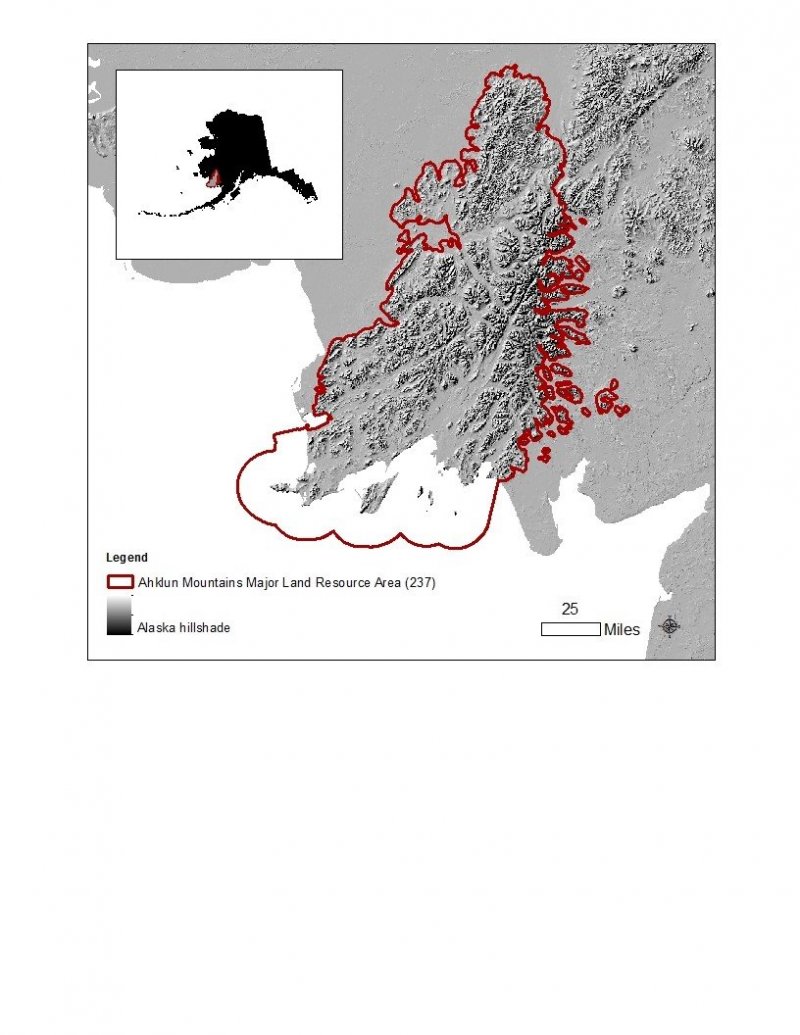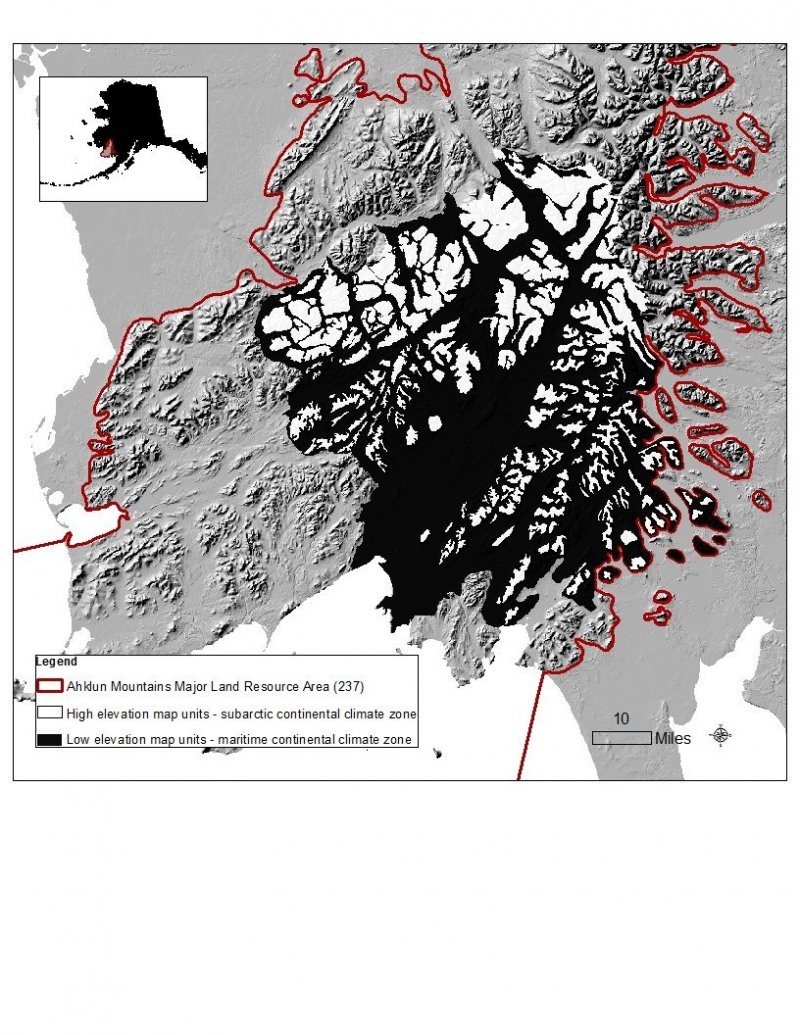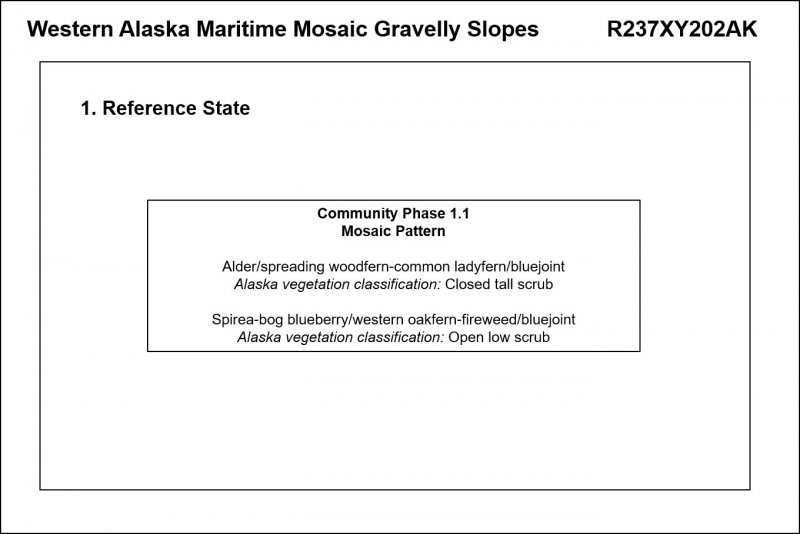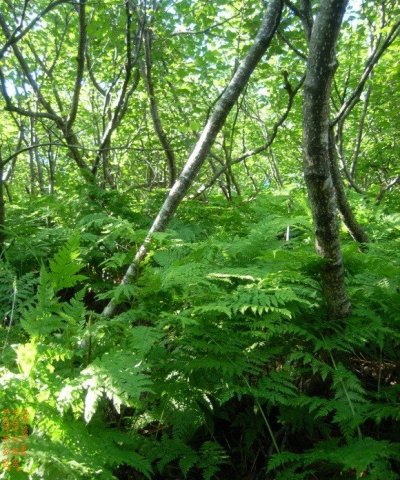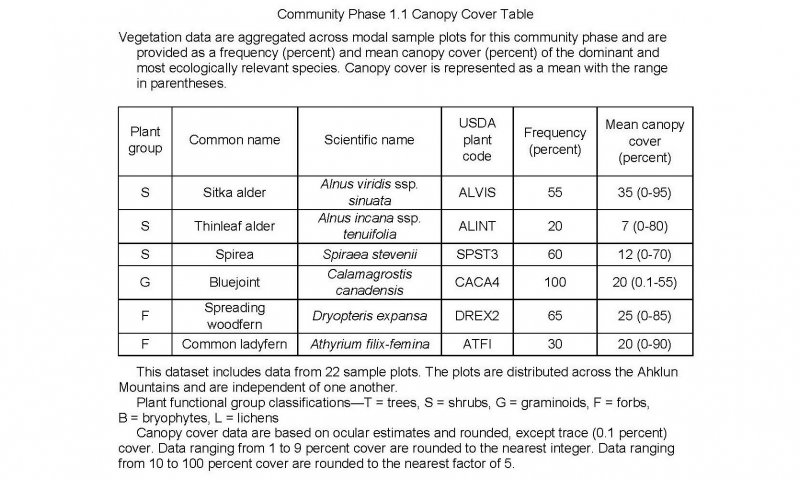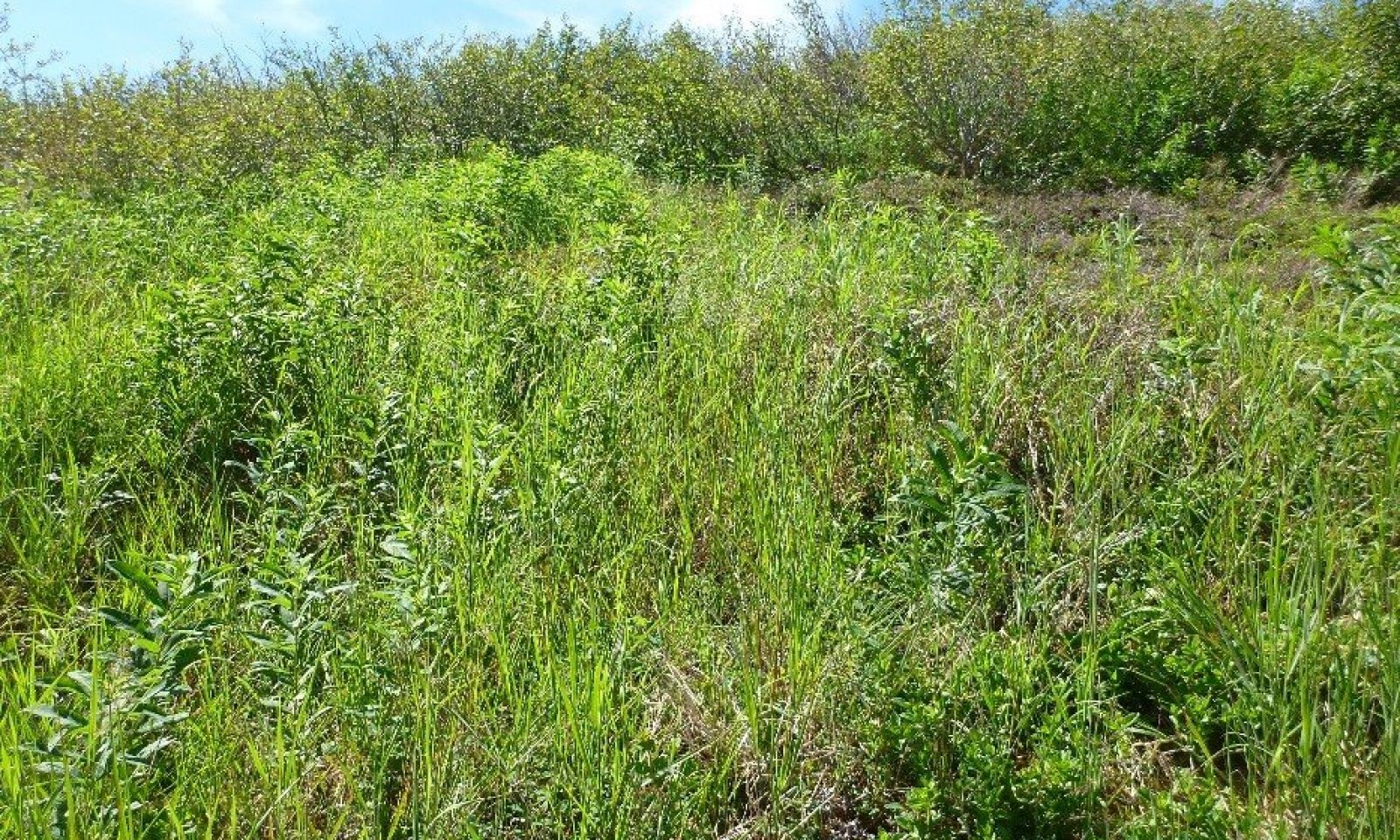

Natural Resources
Conservation Service
Ecological site R237XY202AK
Western Alaska Maritime Mosaic Gravelly Slopes
Last updated: 7/23/2020
Accessed: 12/21/2025
General information
Provisional. A provisional ecological site description has undergone quality control and quality assurance review. It contains a working state and transition model and enough information to identify the ecological site.
MLRA notes
Major Land Resource Area (MLRA): 237X–Ahklun Mountains
The Ahklun Mountains Major Land Resource Area (MLRA 237) is in western Alaska (fig. 3). This MLRA covers approximately 14,555 square miles, and it includes the mountains, hills, and valleys of the Kilbuck Mountains in the north and the Ahklun Mountains in the south. Except for the Kilbuck Mountains and the highest ridges of the Ahklun Mountains, the MLRA was extensively glaciated during the Pleistocene (Kautz et al., 2004). Today, a few small glaciers persist in mountainous cirques (Gallant et al., 1995). The present-day landscape and landforms reflect this glacial history; glacial moraines and glacial drift cover much of the area (USDA-NRCS, 2006). The landscape of the MLRA is primarily defined by low, steep, rugged mountains cut by narrow-to-broad valleys. Flood plains and terraces of varying sizes are common at the lower elevations in the valley bottoms. Glacially carved valleys host many lakes. Togiak Lake is one of the largest lakes in the region. It is 13 miles long and about 9,500 acres in size. Major rivers include the Goodnews, Togiak, Kanektok, Osviak, Eek, and Arolik Rivers. Where the Goodnews and Togiak Rivers reach the coast, the nearly level to rolling deltas support numerous small lakes.
This MLRA has two distinct climatic zones: subarctic continental and maritime continental (fig. 4). The high-elevation areas are in the subarctic continental zone. The mean annual precipitation is more than 75 inches, and the mean annual air temperature is below about 27 degrees F (-3 degrees C) in extreme locations. The warmer, drier areas at the lower elevations are in the maritime continental zone. The mean annual precipitation is 20 to 50 inches, and the mean annual air temperature is about 30 to 32 degrees F (-0.2 to 1.2 degrees C) (PRISM). This climatic zone is influenced by both maritime and continental factors. The temperatures in summer are moderated by the open waters of the Bering Sea, and the temperatures in winter are more continental due to the presence of ice in the sea (Western Regional Climate Center, 2017). The seasonal ice reaches its southernmost extent off the coast of Alaska in Bristol Bay (Alaska Climate Research Center, 2017). The western coast of Alaska is also influenced by high winds from strong storms and airmasses in the Interior Region of Alaska (Hartmann, 2002).
The Ahklun Mountains MLRA is principally undeveloped wilderness. Federally managed lands include the Togiak and Alaska Maritime National Wildlife Refuges. The MLRA is sparsely populated, but it has several communities, including Togiak, Manokotak, Twin Hills, and Goodnews Bay. Togiak is the largest village. It has a population of approximately 855, most of which are Yup’ik Alaska Natives (U.S. Census Bureau, 2016). Major land uses include subsistence activities (fishing, hunting, and gathering) and wildlife recreation (USDA-NRCS, 2006; Kautz et al., 2004).
Ecological site concept
Site R237XY202AK is on backslopes and footslopes of hills and mountains in the maritime continental climate zone. It is on linear to concave slopes. The plants on these slopes differ markedly from those on linear to convex slopes. The soils associated with this site are well drained and moderately deep to very deep to lithic bedrock. The reference state supports a single community in a mosaic pattern. The processes underlying the mosaic pattern currently are unknown; however, it is hypothesized that soil temperature, snowpack, microtopography, and competition for nutrients and sunlight may play a role.
This site supports a tall closed scrubland (Viereck et al., 1992) comprised of alder and an understory of ferns and graminoids intermixed with an open low scrubland comprised of shrubs, graminoids, and forbs.
Associated sites
| R237XY230AK |
Western Alaska Maritime Scrubland Silty Plains and Mountain Slopes, Lower Ecological site R237XY202AK is extensive and is adjacent to or in close proximity to many other ecological sites. Other ecological sites on low-elevation mountains include R237XY204AK and R237XY230AK. These sites are differentiated by the location on the slope, the shape of the slope, or the location in the Ahklun Mountains area. Ecotonal plant communities that have characteristics from more than one ecological site are in areas where these sites abut. |
|---|---|
| R237XY204AK |
Western Alaska Maritime Scrubland Loamy Slopes Ecological site R237XY202AK is extensive and is adjacent to or in close proximity to many other ecological sites. Other ecological sites on low-elevation mountains include R237XY204AK and R237XY230AK. These sites are differentiated by the location on the slope, the shape of the slope, or the location in the Ahklun Mountains area. Ecotonal plant communities that have characteristics from more than one ecological site are in areas where these sites abut. |
| R237XY201AK |
Western Alaska Maritime Scrubland Gravelly Slopes Non-mountainous ecological sites associated with site R237XY202AK include R237XY201AK, R237XY203AK, R237XY205AK, R237XY206AK, R237XY210AK, R237XY211AK, R237XY217AK, R237XY218AK, and F237XY239AK. These sites typically are differentiated by one or more criteria, including landform, landform position, associated soils, disturbance regime, and the type and amount of plants. |
| R237XY203AK |
Western Alaska Maritime Scrubland Gravelly Drainage, Escarpment |
| R237XY205AK |
Western Alaska Maritime Scrubland Loamy Swales . |
| R237XY206AK |
Western Alaska Maritime Dwarf Scrubland Loamy Drainage, High Elevation
|
| R237XY210AK |
Western Alaska Maritime Scrubland Gravelly Flood Plains |
| R237XY211AK |
Western Alaska Maritime Scrubland Loamy Flood Plains |
| R237XY217AK |
Western Alaska Maritime Dwarf Scrubland Gravelly Slopes, High Elevation |
| R237XY218AK |
Western Alaska Maritime Dwarf Scrubland Gravelly Slopes, Concave |
| F237XY239AK |
Boreal Forest Loamy Slopes |
Similar sites
| R237XY203AK |
Western Alaska Maritime Scrubland Gravelly Drainage, Escarpment No other ecological sites in the Ahklun Mountains area support large areas of a mosaic plant community. Site R237XY203AK is on drainage escarpments and supports a reference plant community of dense alder. The location on the escarpments creates an early erosional sere, which is not in site R237XY202AK. |
|---|---|
| R237XY230AK |
Western Alaska Maritime Scrubland Silty Plains and Mountain Slopes, Lower No other ecological sites in the Ahklun Mountains area support large areas of a mosaic plant community. Ecological site R237XY230AK supports an alder scrubland similar to that of community 1.1 in site R237XY202AK, but site R237XY230AK is differentiated by landform and soils. It is on moist plains and in lower mountain swales, and it does not have a mosaic reference state. |
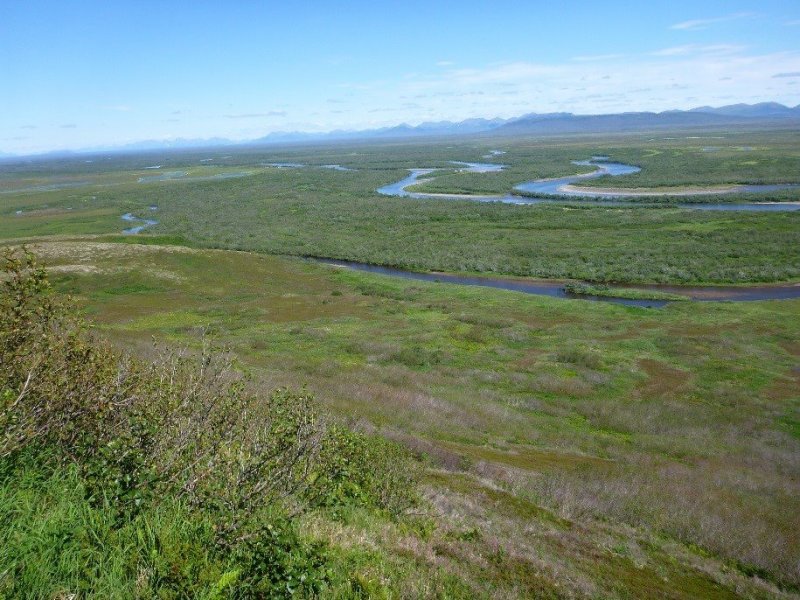
Figure 1. This ecological site extends across large areas of upland mountains and hills in the Ahklun Mountains area. The gray patches are partial defoliation of alder.
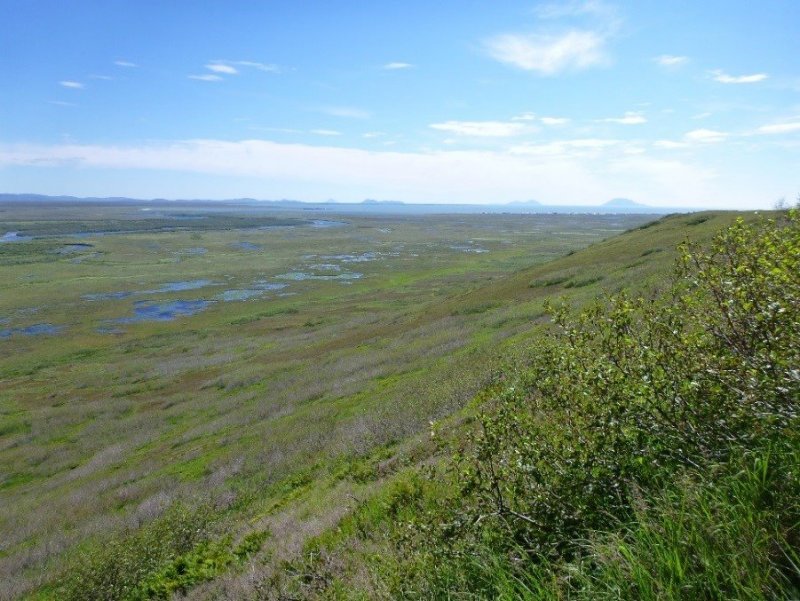
Figure 2. The patchwork of vegetation in this site is evident in the Ahklun Mountains area.
Table 1. Dominant plant species
| Tree |
Not specified |
|---|---|
| Shrub |
(1) Alnus |
| Herbaceous |
(1) Dryopteris expansa |
Click on box and path labels to scroll to the respective text.
